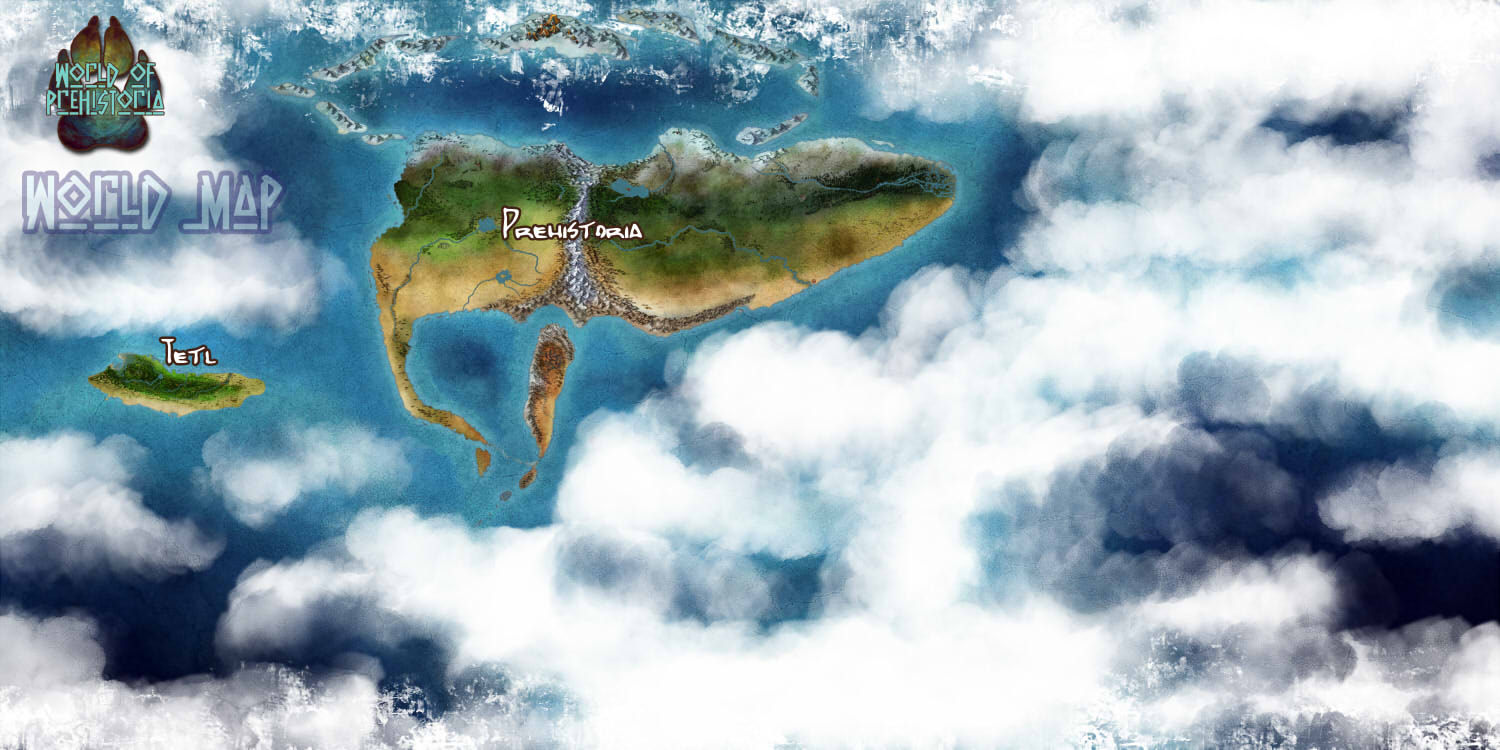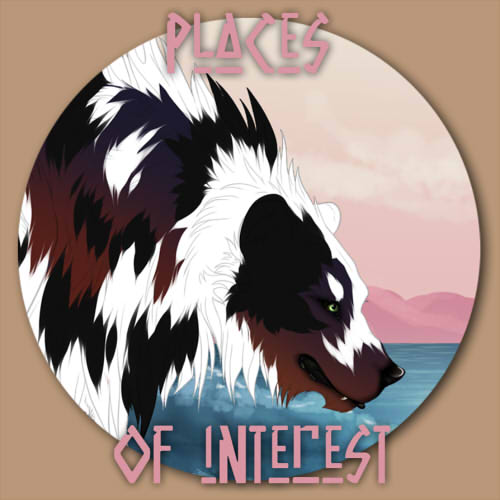
Welcome!
Prehistoria is a big world with many interesting places! If there is a place that catched your interest and you want to know more about it you can find informations about it here.


Legend for the color of the different names:
Places of Interest – Yellow
Deserts – Red
Forests – Dark Green
Mountain and Caves – Brown
Plains – Light Green
Waters – Blue

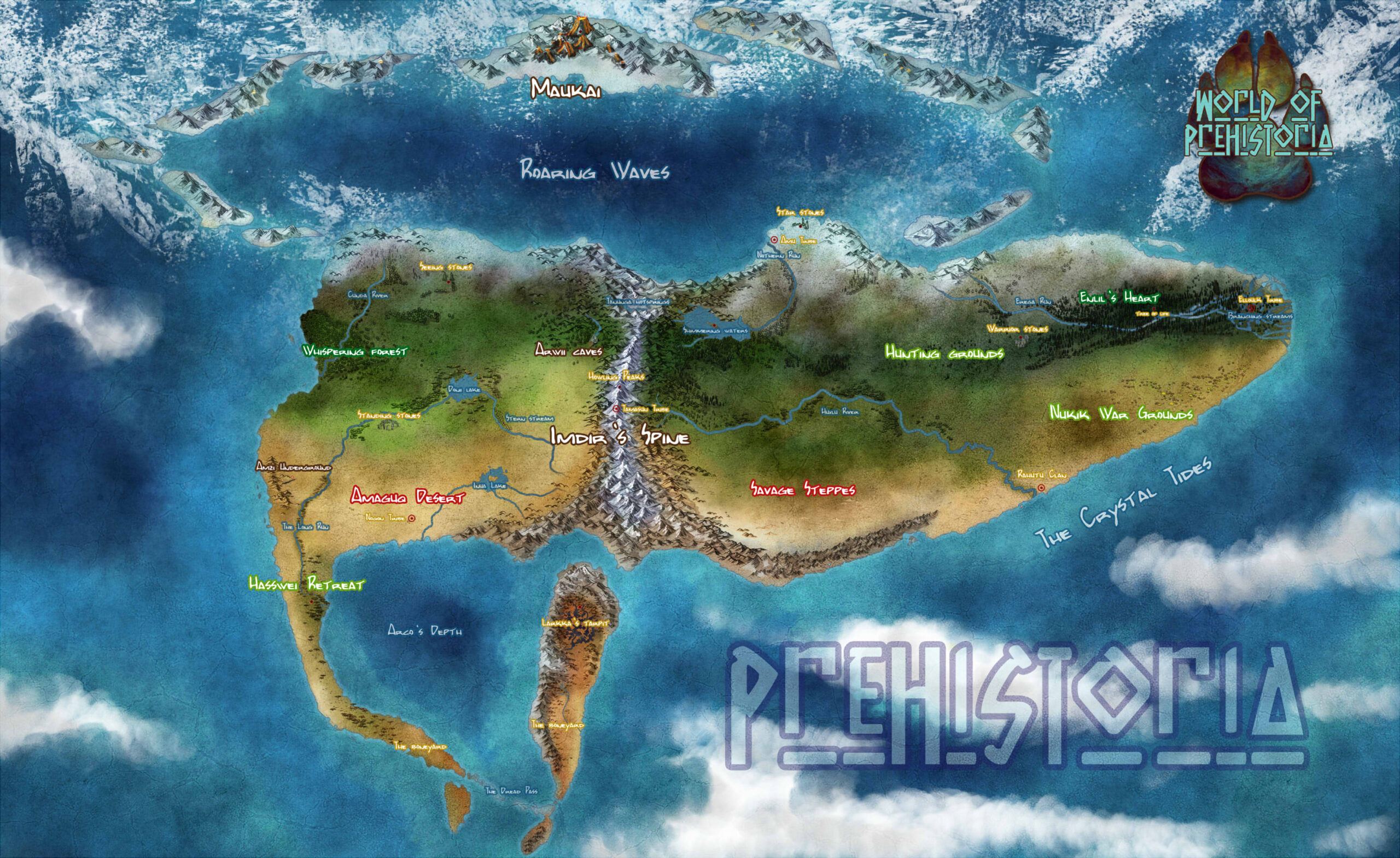
Main Continent – Places of Interest
Star Stones:
These beautiful stones are a sight to behold on a clear, moonlit night. Constellation-like patterns etched into the stones glow under the moonlight, and some say that, if they’re very lucky, one might catch a glimpse into the spirit realm if the full moon is viewed through the round holes bored through the tops of the largest stones. The Star Stones are considered the sacred grounds of the Goddess Umbru, and even the God of the Sun seems to respect her claim to the area. The tundra surrounding these stones spends most of the year shrouded in darkness. At the height of summer, Hasswei finally graces the land with his light and the sun remains hanging in the sky for fifty days. When the sun finally sets and the night is restored, Prehistorians celebrate Umbru’s return with the Shadow of Umbru event held at the stones each year.
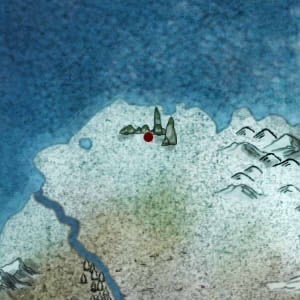
Seeing Stones:
These ancient stones have stood longer than anyone alive can remember. They rest on the Northern side of the continent, in the chilly grasslands that border the tundra. Giant eyes are etched into the outward faces of these massive stones, staring across Prehistoria and keeping watch over the mysterious stone statue within. The eerie, beautiful place is said to have once been the sacred grounds of the God of Knowledge, and a strange power still radiates from them…
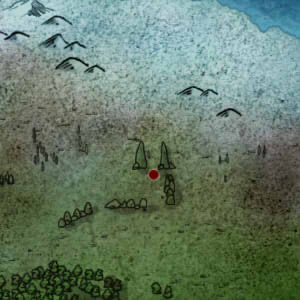
Tree of Life:
This towering giant is the largest tree in all of Prehistoria, resting near the center of Enlil’s Heart. The massive tree is thought to be the very first that sprouted on the continent. It’s a sacred place to Enlil, and many seeking the wisdom of the God of Earth and Plant make their way here to pray to him, sometimes leaving offerings hanging on branches or around the roots and base of the tree.
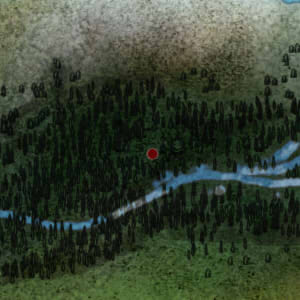
Warrior Stones:
These stone structures are found on the open, grassy plains East of the Hunting Grounds and North of the Nukik War Grounds. These stone “doorways” form a perfect circle, resembling a stone arena within. This is no mistake, for these stones mark the sacred grounds of the Goddess Assur. The site has become a place of celebration and competition, and many games and contests have been held here. Important competitions, such as a clash between two mighty and honored warriors, might take place here so that the Goddess of Courage and Honor might bear witness.
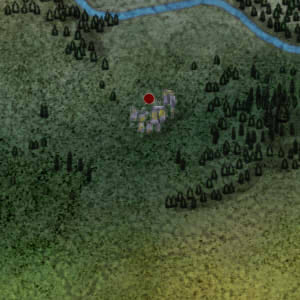
Howling Peaks:
On the highest mountain of Imdir’s Spine, the ever-blowing winds seem to sing. At times, there is only a whispering breeze, and others it’s more of a screaming howl, chilling travelers to the bone. The Howling Peaks are the sacred grounds of the Goddess Imdir herself, and those seeking her guidance brave the eerie winds to pray to her at this holy site.
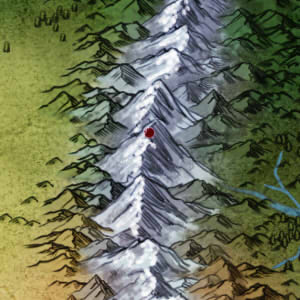
Standing Stones:
A sacred place of the people, these stones were erected by ancient men and beasts as a place for important gatherings, such as meetings for tribe leaders, and celebrations of all sorts. Some Prehistorians will gather here to celebrate the holidays as well, such as a mother with young who doesn’t wish to brave the icy cold to celebrate the Shadow of Umbru event at its official grounds at the Star Stones.

Amu Tribe Settlement:
This tundra located a few days walk from the Star Stones is the territory of the Amu Tribe.
Semi-nomadic, they live according to the seasons and the rhythm of life of the animals they raise. The sometime harsh weather doesn’t faze them and they know how to survive in there.
The people of Amu are rather friendly people that aren’t known to harm strangers…unless they are actively poaching or hunting their livestocks.
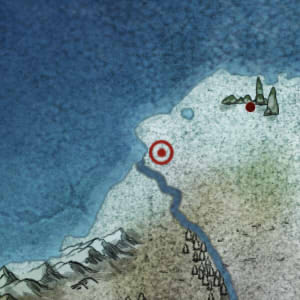
Elloulk Tribe Settlement:
Somewhere deep in the Enlil Heart, a small group of humans received the rare blessing of the God Enlil and the permission to settle there. Thus was born the Elloulk Tribe.
Their camp is located in the heart of the forest, both on the ground and in the trees. Very open and hospitable, they are known to share their immense knowledge of the local flora and many great healers have learned their science from them.

Nogon Tribe Settlement:
The Amaguq Desert is a cold and desolate place where it is extremely hard to survive. But this desert has nevertheless become the home of the Nogon Tribe. Nomads, their members move constantly according to the rare resources given by the desert. Extremely peaceful, they welcome travelers and adventurers as brothers and help them cross the desert. They are also known to be excellent storytellers capable of telling unforgettable stories.
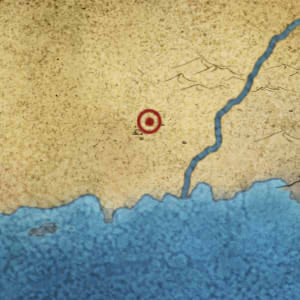
Rahutu Clan Settlement:
This coastal village is where the Rahutu Clan first landed on the shores of Prehistoria. This strange hamlet rests half on the shore and half over the water, with their huts raised on stilts. It is their main camp on the continent. They greet new travelers here and Expedition adventures begin on the clan’s docks, offering use of their ships to reach the islands – once passage has been paid, of course.
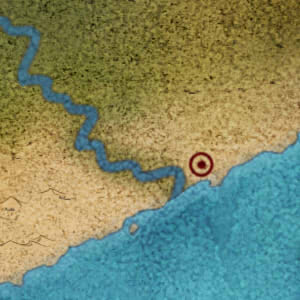
Tamasun Tribe Settlement:
Deep in one of the mountains of the Imdir Spine, hidden by the maze of paths and frozen rocks, lies a giant cave. And in this cave lives one of the harshest Tribes that Prehistoria has ever welcomed into its lands. The Tamasun Tribe.
Among its members live the most battle forged warriors that exist, with the blessing of the Goddess Assur and the Snow King himself.
Beware if your steps lead you to their territory! They are known for their hostility towards strangers. Unless you are a warrior, but you will have to prove yourself before being accepted by them…
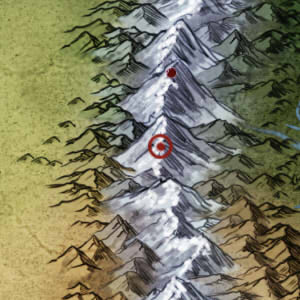
Larkka’s Tar Pit:
These deadly black lakes are the sacred grounds of the Goddess Larkka. Travel here is not to be taken lightly, as the treacherous environment has taken many men and beasts to meet the Goddess of Death in a more permanent way than they may have intended. Nestled high between two mountain ranges, the area is constantly battered by cool, dry winds from the mountains as well as warm, humid sea spray. A volatile everlasting thunderstorm rages overhead, with lightning strikes that illuminate the mountains even in the dead of night. The dark pools themselves might at first seem like any other smelly swamp, but those who set foot in the viscus black pits may never be able to fight their way loose again. The rotting remains of these unfortunate souls can be found scattered in and around the pits, a clear omen to any who dare venture so far.
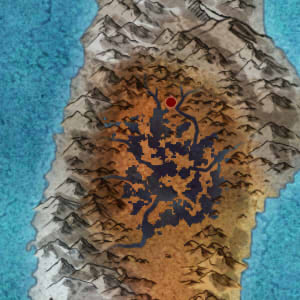
The Boneyard:
This massive graveyard spans the Southernmost reaches of the continent. Many of the beast species migrate to this area when they sense that their time in this world is coming to an end, as if called to Larkka’s Tar Pits by the dark Goddess herself. Large mammal remains, especially mammoth bones, are found in abundance, but within the yard’s depths one could find the bones of any creature that walks Prehistoria. The Boneyard seems a creeping skeletal hand, and it’s not uncommon to find a stray carcass in the Southern areas of Hasswei’s Retreat. Scavengers are frequently drawn to this area in search of a free meal or, for those who are so inclined, the perfect bone.
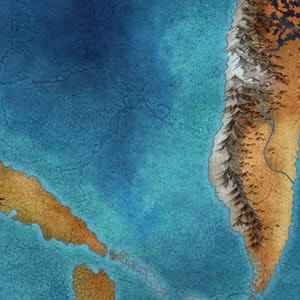
Main Continent – Deserts
Amaguq Desert:
Most of the deserts of Prehistoria are cold, desolate areas, and the vast Amaguq Desert is no exception. Temperatures in the area drop drastically as the sun goes down, and survival in the desert is hard. In the dry season, harsh winds frequently whip up sandstorms, reducing visibility and turning travelers around, and the wet season often brings fierce thunderstorms. Inhabitants of this place are typically nomadic, as resources here are too scarce to support many settlements.
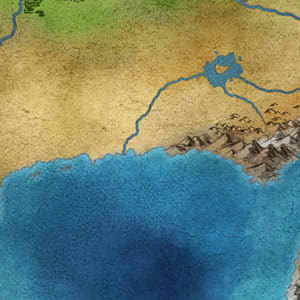
Savage Steppes:
Buffeted by bitter winds from the mountains, this dry grassland is, at first glance, little more than a frigid wasteland. Little grows here aside from tough grass and sparse shrubs, and there is no tree cover from the harsh wind and occasional storm. Settlements are extremely rare here, though it’s said that some clever peoples have taken to living underground. The only creatures hearty enough to thrive in the area are the mighty mammoths, and several nomadic herds roam the Steppes.
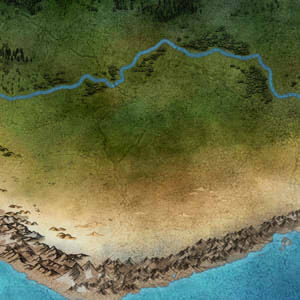
Main Continent – Forests
Enlil’s Heart:
Considered by many to be the most beautiful forest in all of Prehistoria, this sprawling woodland is filled with lush plant life that grows year-round. It is said that this forest is Enlil’s playground, where he experiments with new types of plants. There are places here where one can find flora unlike anywhere else in Prehistoria, such as flowers that glow softly and mushrooms that grow as tall as the trees. The forest can be dangerous, however, and travelers are warned not to cut through the thick undergrowth as they attempt to travel through the forest. Many travelers have disappeared among the plants and some say Enlil entraps disrespectful trespassers in the very trees that make up the wood. Alongside the wondrous, bright, and fragrant plant life, there are plants that feast on flesh and flowers whose pollen can lull an unweary traveler into an eternal slumber, so that their bodies wither into plant food.

Whispering Forest:
This forest sprawls for miles across the western side of the continent. The Whispering Forest holds within it many mysterious places, some with known names and others lost to the passing of time. The woodland is so thickly overgrown that it seems to change without warning, and many unprepared travelers have gotten themselves turned around in the natural labyrinth, never to be seen again. There are legends of undiscovered treasures hidden within the forest, and some say that, if you listen carefully, you can hear the spirits’ whispers to guide the way. There are whispers that a powerful entity with infinite knowledge rests within the Whispering Forest, trapped there long ago by some forgotten event…
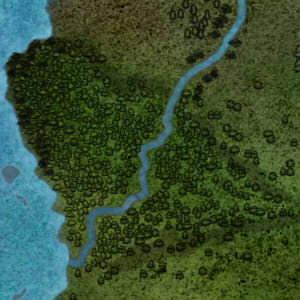
Main Continent – Mountains and Caves
Maukai:
An ancient, active chain of volcanoes rings the arctic circle around the North pole of Prehistoria. It is said that the main spout formed when the world was born. Bold adventurers have been rumored to explore these volcanic islands, though there aren’t many alive who can tell the tale firsthand. The weather here is fickle, torn between the brutal volcanic heat and hostile arctic cold. Violent snow and ice storms ravage the archipelago, and travel is made even more difficult and dangerous by the sharp, hardened ground made from cracked, uneven obsidian formations. To make matters worse, visibility in the area is extremely poor. The arctic circle is split between nearly a year of darkness, lit only by the menacing glow of the lava, and fifty days of blinding sunlight glaring off the ice and snow. The volatile weather often creates a thick cloak of fog over the rocky islands. While true eruptions are rare, the volcanoes are no less dangerous and most ooze steady streams of lava into the icy sea. The largest of these volcanoes is called Maukai. This imposing monster of a mountain is frequently seen smoking, and any who dare venture close enough to peer into its depths can see the glow of a churning molten lake lurking within. There are whispers that the God of Chaos is imprisoned here, deep beneath the magma, plotting his revenge…
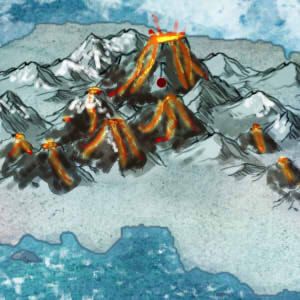
Arwii Caves:
The walls of this deep, ancient cave system are painted over with many images of animals, landmarks, important historical events. Generations of prints from man and beast alike cover the place, honored to leave their mark on the stone walls for the rest of time. The Arwii Caves are considered a holy place sacred to Arwii himself. It is home of the Sacred Spring, and many Prehistorians visit the caves to seek the wisdom of the God of Life. A river flows down from the mountains and into the cave system. It seems to disappear into the stone deep within, but it’s said that if one were to throw an item into the river, they might find it again near Donii Lake. This is considered a very good omen!
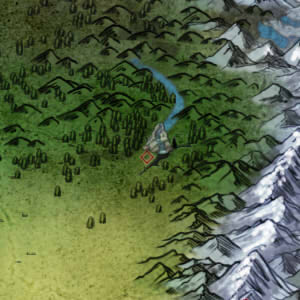
Imdir’s Spine:
This massive mountain range stretches from the arctic oceans in the north to the arid southern coast, splitting the continent in two. It can be dangerous to travel through the mountains, but many have found safe routes through Imdir’s Spine and there are a few ancient paths that Prehistorians have used and shared with one another for generations. Winds can blow harshly through the mountain range, and some travelers leave offerings to the Goddess Imdir at the base of the range, in hopes that they might be granted a safe journey.
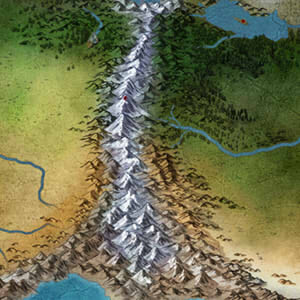
Amzi Undergrounds:
This strange cave burrows deep into the earth. Not much is known about this mysterious place. Its entrance was once sealed, the original mouth of the cave having been destroyed in a time long forgotten. Some curious Prehistorians have rediscovered its existence, and only the Gods might guess how long it had been since mortals had set foot within. What seemed like a normal discovery soon turned eerie, and tales spread that the cave was haunted. Strange, twisted drawings line the cave’s walls, and horrid screeching sounds echo from within its depths. The further in one dares to venture, the more skeletal remains can be found. It’s said that no one has dared to locate the central chamber of the cave network, not even those who discovered the sinister place to begin with…
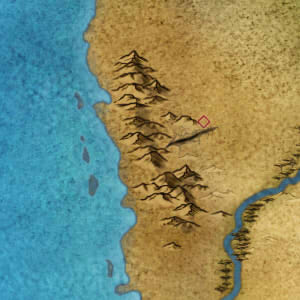
Main Continent – Plains
Hunting Grounds:
These sprawling tundra plains grow thick with hearty arctic plants, supporting a multitude of game animals of all sizes. The air is crisp and clean and the sunlight warm and welcoming. Prey species thrive here despite this area being considered a hunter’s paradise to many Prehistorians. Hunters freely test their might against some of the largest animals to roam the continent, and each year new young thrive in place of those who have fallen. It’s rumored that Hasswei himself has blessed the Grounds with its bountiful game.
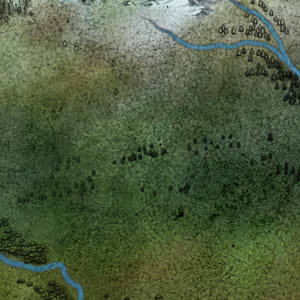
Nukik War Grounds:
A rolling grassland dotted with shrub thickets and small forests. The soil in the area is rich and red, said to be stained by the blood shed in hundreds of wars fought across the land. Warriors flock to the Nukik War Grounds to seek the blessing of the Goddess Assur and prove their strength in battle. Despite the violent nature of these gatherings, the climate in the area is fairly mild, with a warm dry season followed by a cooler rainy season.
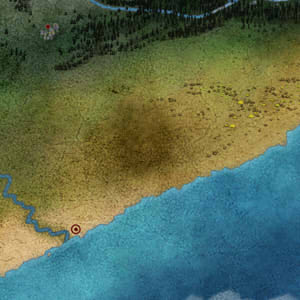
Hasswei’s Retreat:
These rolling golden grasslands are filled with life of all sorts. A hot, dry desert spans the western coast, a stark contrast to the Amaguq Desert to the Northeast. Here, Hasswei’s heat graces the land, and men and beasts alike thrive. The sheer number of prey species makes hunting a very popular activity in the area. The savannah is considered the sacred grounds of the God of the Hunt, and many hunters seeking the great worg’s blessing are sent here first to be tested.
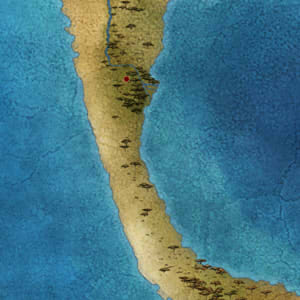
Main Continent – Waters
Sacred Spring:
If one were to follow the glowing mushrooms deep within the Arwii Cave system, they might find a cavern filled with sparkling pink and blue crystal formations. A shallow pool takes up most of the cavern, its waters appearing to glow in the light of the fungus overhead. The pool is shallow, only waist-deep to most, and the smooth stones that cover the bottom can easily be seen through the clear, blue water. It is said that all life in Prehistoria began at this spring.
Tanunga Hotsprings:
Hidden high on the Northern edge of Imdir’s Spine, the Tanunga Hot Springs are a treasure to any who are able to find them. The warm, mineral-rich waters are said to revitalize the body and ease the mind, and the area around the springs are a notoriously peaceful place, with Prehistorians of all shapes and sizes sharing the pools. Many creatures gather here to soak in the springs and share stories of their adventures.
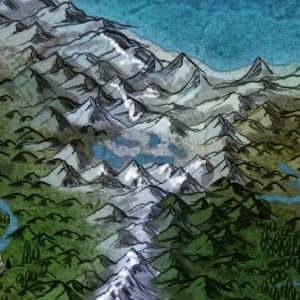
Shimmering Waters:
The largest lake in all of Prehistoria, the Shimmering Waters appear almost crystalline. The lake is considered the sacred grounds of the God Hathar, and is blessed with thriving aquatic life year-round. It’s said to be so full of fish when the salmon come to spawn that you need only open your jaws and wait for a fish to leap into it! It’s a favored place of many Prehistorian fishers.
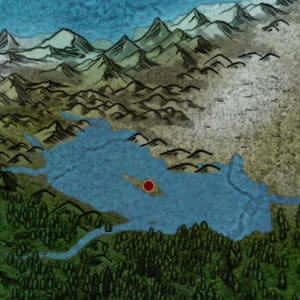
Donii Lake:
A cool, refreshing lake, teeming with life. Flora and fauna alike seem to thrive here, and the lake is considered sacred to the Goddess it takes its name from. Spring celebrations are often held on the lake’s shores, and Prehistorians often pray here to ask the Goddess to bless them with healthy children, or to help themselves or a loved one heal from an injury or ailment. The waters are said to have healing properties, able to soothe aches and pains and encourage healing in those who drink from or bathe in the lake.
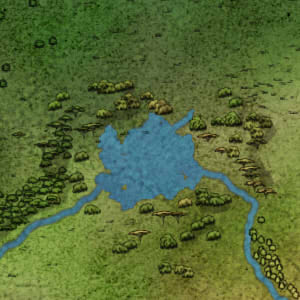
Inua Lake:
This lake is a lifeline to those who live in the sparse Amaguq Desert. Each year, the lake dries up as the rains disappear, and as the wet season begins again, many inhabitants in the area hold ceremonies and rituals, praying to Arwii for the lake’s return. Inua Lake seems to hold some value to the God of Life as well, for this is where he tests mortals seeking his blessing.
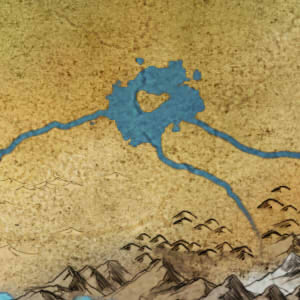
The Dread Pass:
This thin land bridge is the only safe way to reach the heart of the Boneyard, and Larkka’s Tar Pit. The pass disappears beneath the waves as the tide rises, and emerges once again when the tides go out. Careless travelers might find themselves stranded on the barren island, and many a fool who was too impatient to wait for the bridge has been swept away by the tide.
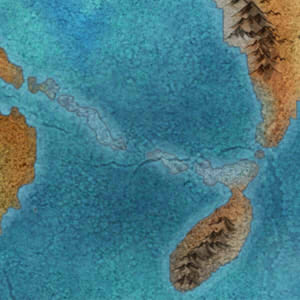

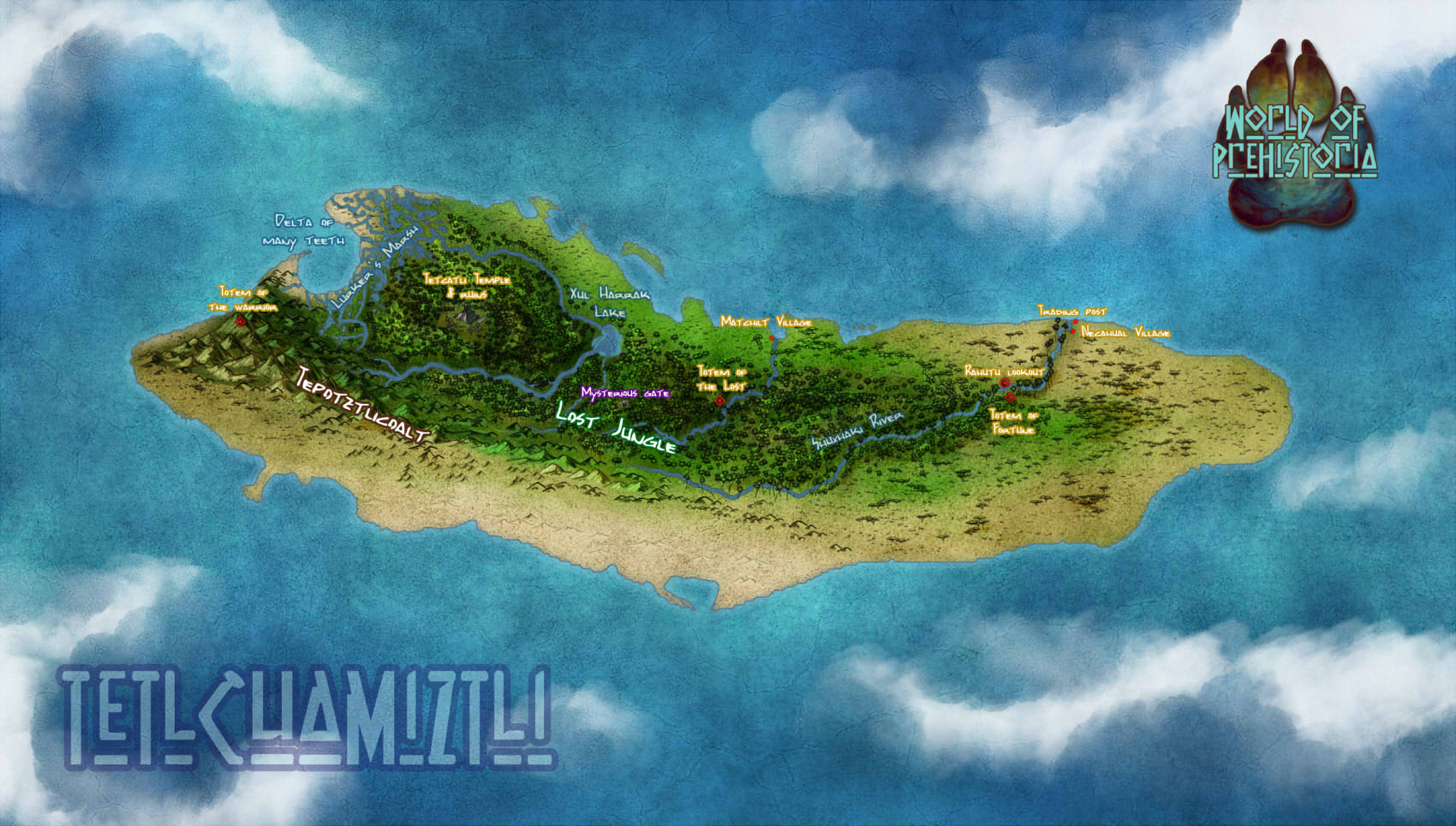
Tetlcuamiztli Island – Places of Interest
Matchitl Village:
This strange village belongs to the Rahutu, though its inhabitants seem to be Prehistorians of all sorts. Tucked along the Northern coast of the island, Matchitl Village takes some getting to, and can easily be missed by uninformed travelers. Despite its secretive location, the villagers are welcoming, helpful, and kind. Often, explorers seek out the village as a place of rest. A few may decide not to leave for a while, so it’s not uncommon to see outsiders living among the Rahutu here. The Rahutu villagers seem to be a little more open about their clan’s secrets, and they say that any who can find their way to Matchitl Village have been deemed worthy by the jungle and the island.
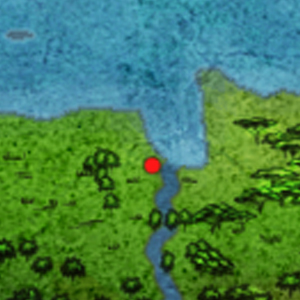
Necahual Village:
This village is said to be the main home of the Rahutu Clan and is often one of the first places new explorers see on the island. However, the Rahutu often keep the gates to Necahual Village closed, and encourage travelers to visit the nearby Trading Post instead. They will occasionally invite in more trusted outsiders, but like much of the island, the village remains shrouded in mystery.
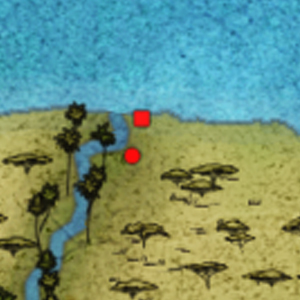
Rahutu Lookout:
A tall sentinel post downriver from the Rahutu Trading Post. A brazier burns at the top of the post, acting as a lighthouse to those within the tangles of the jungle. If an adventurer loses their bearings in the wood, they can easily find their way again if they can manage to climb high enough to see over the canopy.
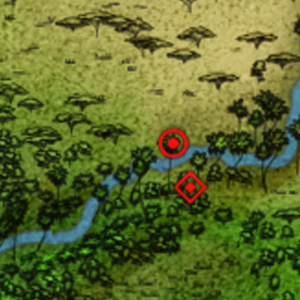
Tetcatli Temple:
This huge pyramid-temple rests near the center of the island, surrounded on all sides by thick jungle. Though the temple is now a crumbling ruin, the remains of once-beautiful mosaics and elaborate sculptures can still be seen. Most of the details of these ancient artworks have been worn away over time, the shapes of massive saber cats covered in rosette spots. The locals say that the temple was once used to worship a cat-like deity whose avatar roamed the jungle as its protector. Some adventurers say that he and his descendants still prowl the jungle, and spread tales of eerie happenings. There are stories among the locals that the temple is haunted by the spirits of the island’s ancient inhabitants, and many say that they feel as though they are being watched while they explore the area. Countless treasures made from gold and precious gems remain untouched within the temple, for most dare not invoke the wrath of the spirits and the feline deity.
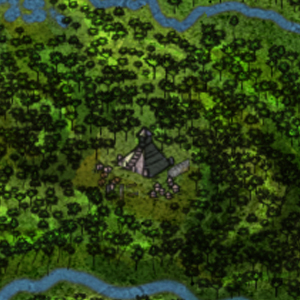
Totem of the Warrior / Lost / Fortunes:
Three ancient, carved stone statues stand on the island, each one the likeness of a different creature. While it’s certain that these totems are of great significance, their true purpose seems to be lost in time. Offerings are sometimes left at the bases of the totems, but the peoples of the island have either forgotten the story behind them or choose to keep it hidden from outsiders.
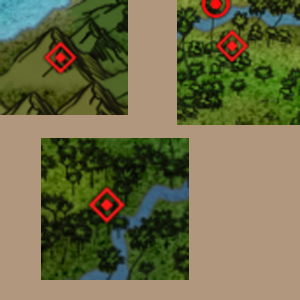
Trading Post:
Often the first place a new explorer sets foot on the island, this happy, bustling trading port is nestled safely in a bay on the Northeastern coast. This safe haven is well-protected from the jungle’s many dangers, and connected to the nearby village and lookout post via river. It acts as a cultural bridge between the outside world of Prehistoria and the native peoples of Tetl.
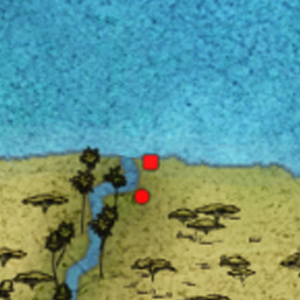
Tetlcuamiztli Island – Forests
Lost Jungle:
This dense tropical rainforest covers most of the island. A beautiful tangle of greenery, the trees grow so thickly and closely together in some places that it’s nearly impossible to pass through on the ground, and it’s easy to get turned around and confused by the natural labyrinth. Nevertheless, the jungle is teeming with life that can only be beheld on the island. Brightly colored birds and impossibly loud monkeys populate the treetops, alongside lizards and snakes of numerous size and shape. Invertebrates like beetles and spiders grow much larger here than most places on the mainland, and a swarm of biting insects plagues most of the jungle. Even the dark waters of the rivers that cross the land cannot be trusted. It’s said that countless absent-minded travelers have disappeared into the jaws of the reptilian monsters that lie hidden near the banks.
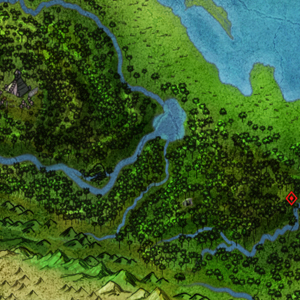
Tetlcuamiztli Island – Mountain and Caves
Tepotztlicoalt:
This mountain range spans most of the Southern part of the island. While there are safe paths through these mountains in the more gentle areas, its peaks are often avoided, and many new travelers are warned away. With the Totem of the Warrior hidden deep within the highest area, it occasionally sees a few brave explorers. With a name that means “Snake Back”, it’s no surprise that paths through this range seem to wind at random, and all but disappear in some places. There are many sudden drops and steep falls, and it’s quite easy to lose one’s life to Tepotztlicoalt.
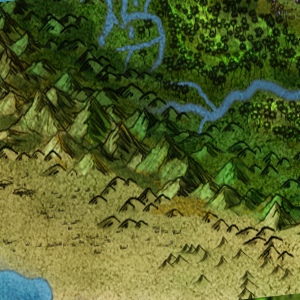
Tetlcuamiztli Island – Waters
Delta of Many Teeth:
The rivers slow to a crawl as it nears the ocean, but adventurers shouldn’t let their guard down on this corner of the island. The Sarcosuchus that call the Lurking Marsh home also frequent the Delta of Teeth, and the place is aptly named. The waters are dark and murky, and with many twists and turns, there are many places for the beasts to hide. Even the most experienced travelers among the locals are wary of the area, as they say a life can be ended here with very little warning.
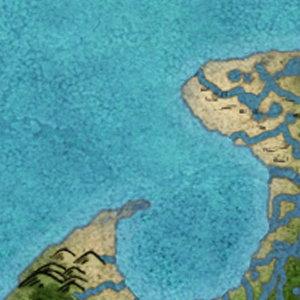
Lurker’s Marsh:
This dense swamp stretches along the Northwestern coast of the island. Most of the area is covered with deep bog, and what ground exists consists mostly of impassable muck. The strange trees’ gnarled roots twist across the mud, creating some stable footing and holding the plants above the water. It’s said that the trees are able to slowly walk themselves to more favorable parts of the bog on these strange roots, resulting in a confusing, ever-changing landscape that one can easily lose themselves in. To add to the danger, many large predators fill the deeper waters, preying upon unsuspecting adventurers who venture too close.
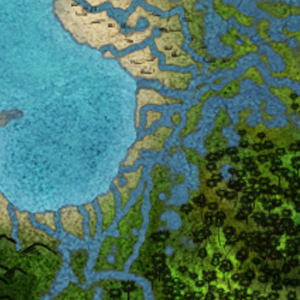
Shuxhaki River:
With branches that spread from one end of the island to the other, Shuxhali River is the largest on Tetl. For most of its length, it’s a deep, fast-moving river with frothy rapids and treacherous waterfalls. Its path is full of twists and turns, and slow, calm parts of the river are rare. For this reason, travelers are often warned to keep their boats out of the churning waters, for even traveling on foot through the jungle may be safer. The river is popular among fishers, however, as its waters are home to many large, hearty species of fish.
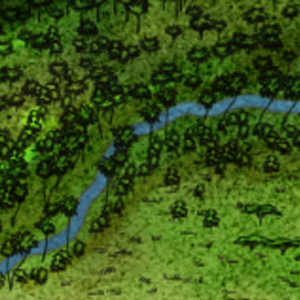
Xul-Harrak Lake:
A clear, sparkling lake should offer a rare respite from the dangers of the jungle, but novice travelers are warned to keep their distance from this place. The lake is deep and dark, but diving into it is considered foolish. Its depths are said to be a spiritual gateway, and the locals claim the area is haunted by the restless souls of the damned. Some say that when the fog rises from the waters, as it often does, the mist is full of voices and shadows from beyond the void. The waters are thought to be a powerful base for potions and brews, though some more superstitious locals insist that those who dare drink from the lake are sure to find themselves cursed.
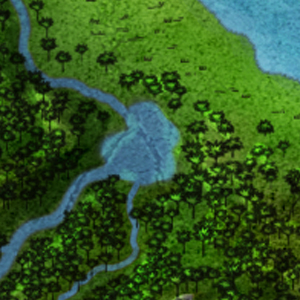
Tetlcuamiztli Island – Misc
Mysterious Gate:
This strange stone structure is aptly named. Hidden deep in the heart of the Lost Jungle, few of the Rahutu Clan have laid eyes on it, and even fewer outsiders have managed to find it. It looks almost like an unfinished ruin at first, there’s a platform with a stone doorway, and pillars circle the area. The gateway and stones are worn and covered in moss, but markings can still be seen carved into their surface. It’s unknown whether these markings are elaborate decorations or writing in a language long forgotten, but it’s said that they glow under the moonlight. If one were to stand in front of the gate, it would be impossible to miss the piercing eyes of the nearby snake statue. It stares down at the gate expectantly, its hungry maw wide-open. Worn steps lead up to its head, and its tail winds down to a stone basin near the bottom. Some say that if given the proper sacrifice, the snake will open the gate, though no one can say where it might lead…
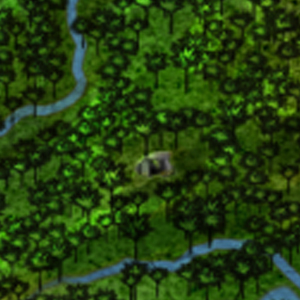
Pool of the First Guardian:
There is little information to be found on the Mysterious Gate, and even less is known about the nearby Pools. The jungle here grows so thickly, no light is able to shine in from above, but the area is lit by strange glowing plants and luminescent waters. There are whispers that a spirit guards the area, though descriptions of him are broad. Sometimes he’s depicted as something large and angry, and others describe him as mournful. It’s said that he often confuses travelers who get too close to the Pools, calling up fog and warping their minds. Survivors are often found bewildered, disoriented, and with little memory of what happened to them.
Tree of the Ancient:
Though it’s said that this mysterious landmark can be hard to locate, it’s certainly hard to miss. The tree seems older than the island itself, and stands out from the jungle around it in many ways. Its trunk is bigger around at the base than some of the huts in the villages, and it stretches high above the trees that surround it. With its dark, hard bark and deep purple leaves, the tree seems out-of-place and almost alien compared to the lush, green jungle, though those who find it claim its presence brings a feeling of peace. Wild animals in the area flock to the tree, and its canopy is alive with birdsong. The few who have been courageous and skilled enough to climb into its branches say that there’s a miniature jungle within its boughs, with smaller trees and shrubs growing from its branches. Others say this jungle in the sky is a fairytale, made up for bragging rights and bedtime stories. It’s so rare for anyone to make it high enough into the tree to find out, it’s hard to prove for sure. It’s frowned upon by the locals to try to cut into the tree, though its iron-hard wood has broken many blades. Occasionally, a limb or branch will fall to the jungle floor. These are seen as gifts, and they are quite sought after.
